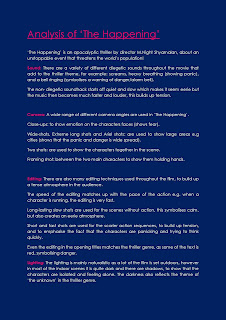Last week in lessons we began to start analysing extracts from thriller films. We watched: The Village, The Firm, and Collateral. These are all different types of thriller films, however when I began analysing the extracts it became clear that they all used similar techniques. I focused on: lighting, sounds, camera angles/movements and editing. These are the notes I made when watching the extracts:
The Village: Lighting: Naturalistic daylight at first but it gradually gets darker, which builds up tension. Contrast between light & dark/calm & fear. Pathetic fallacy (the weather reflects the mood of the scene).
Sound: At the beginning there is a man talking slowly in a deep, clam and serious voice, this creates and eerie atmosphere. Exaggerated loud bang on the trap door (dramatic). Music starts slow to symbolise the 'calm before the storm', but it gets faster and louder as the danger draws closer, this builds up tension. There is a ringing bell, symbolising a warning/alarm.
Camera: Framing-shots through the trees, like the characters are being watched. Close-ups on the characters faces to show their scared facial expressions. Zooming in on symbols/signs e.g. the blood marking on the door. The shots are steady for the calm section of the extract, but as the tension builds up and there is more and more action, the camera movements become jerky, to show the panic.
Editing: Slow editing at first, eerie and calm. Fast short shots for the more dramatic sections. Fades to black, relates to the theme of darkness.
The Firm: Lighting: Realistic lighting, natural daylight. The light is brightest on the protagonist, to keep the main focus on him.
Sound: Ticking, an indication that time is running out, this also creates tension. The music starts when the villain comes into focus, and then gets faster and louder as he gets closer to the protagonist (builds tension). Not much diegetic sound from the extras in the scene, this keeps the focus on the hero and villain.
Camera: Close-ups on the protagonist to show his facial expressions, this makes the scene more intense. Tracking and panning shots when running, keep up with the fast moving chase. The camera movements steady on the calm hero, but are jerkier on the villain, as he runs. Shows contrasts between the hero and the villain.
Editing: Slow editing at first, but gets faster with shorter shots as the action speeds up. Jump-cuts from hero to villain.
Collateral: Lighting: Darkness and dim/low lighting creating nightclub atmosphere with spot lights and strobe lighting. Sets the scene. Creates confusion. Dark lighting shows that the characters feel isolated.
Sound: Exaggerated loud night club music with heavy bass (sets scene). Diegetic sound: screams, gun shots, punching, glass smashing, and stabbing noises, all of which emphasises the violence.
Camera: Close-ups show characters emotions and focus on particular characters. Chaotic, fast camera movements.
Editing: The surroundings in the scene are blurred to keep the focus on the main characters and to create a chaotic atmosphere. Jump-cuts getting faster as the action and violence starts. Jumpy, short shots, fast pace to keep up with the speed of the action.














